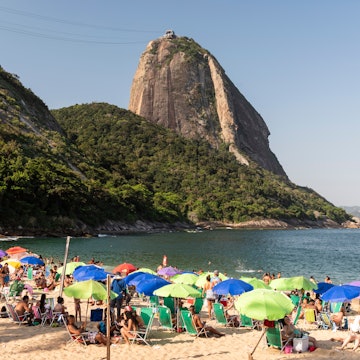
Return to nature in the magical hills of the Sierra Nevada, Colombia
Sponsored by
Aug 8, 2022 • 5 min read

The Sierra Nevada de Santa Marta mountains of Colombia are a return to nature, far away from the hustle and bustle of Cartagena and Barranquilla © Image by streetflash / Shutterstock; Graphics by Jacob Rhoades / Lonely Planet
Set in the Sierra Nevada de Santa Marta mountains is Minca, Colombia – where lush, green jungle tumbles down to the Caribbean beyond. Continuing east is a long stretch of coastline from Tayrona National Park to Palomino where the sea is wild with crashing waves. It’s a return to nature, far away from the hustle and bustle of Cartagena and Barranquilla.
Time moves slowly here, but there’s plenty to do, from tubing down the Rio Palomino with a beer in hand to hiking with the local indigenous tribes and learning about native flora and fauna.
Whether it’s an extended backpacking trip in the region or a weeklong holiday, this sublime region of Colombia is more than a day trip destination – it’s the perfect alternative to other, more heavily visited, parts of the country.

Minca
Awe-inspiring views top of the list of the many reasons to visit Minca. Wherever you choose to stay in this lush, hilltop town, you’ll be greeted by a panorama of the greenest green.
Just a 45-minute drive from Simon Bolivar Airport in Santa Marta, Minca feels like another world. The Sierra Nevada is the highest coastal mountain range in the world, and the town's elevation keeps it cooler than the tropical coastline below, creating an ideal environment for flora and fauna.
Colombia is one of the most biodiverse countries in the world and tops the chart for a variety of birds. Minca is a perfect spot to explore this biodiversity close-up. Nature reserves here are home to roaming jaguars, howler monkeys and hundreds of bird species. It’s well worth hiring a local guide to make the most of this remarkable environment – Jungle Joe is a one-stop shop for all things nature and Minca.
The climate is also ideal for growing coffee and cacao. Colombia is a world-renowned coffee lover's paradise, and you don’t only have to visit Zona Cafetera for a traditional coffee farm experience. Minca has its own selection of authentic coffee fincas. Hacienda La Victoria is the oldest in the area, while Finca La Candelaria takes an organic approach to its coffee and cacao production and offers B&B accommodation.

When you’re ready to explore the tropical forests, Minca has a wide variety of hiking trails for all skill levels. Not all trails are signposted, but local guides are available. Two particularly well-trodden trails are the hikes to Cerro Kennedy (which can also be done as an overnight trip) and Los Pinos. The views from the summit include cloud forest and, from Cerro Kennedy, a vista of the two tallest mountains in the country.
Wild camping and jungle night tours take the sense of adventure to the next level. There is no better way to reconnect with nature than under a canopy of forest and stars, listening to a soundtrack of night-time creatures.
If you prefer cycling to hiking, Minca offers thrilling mountain biking trails that tackle tricky terrain and traverse multiple ecosystems. Or perhaps you prefer a calmer jungle experience – yoga lovers will find plenty of classes to choose from under the canopy.
One activity everyone can agree on is a dip in a refreshing natural pool. Locals and visitors alike flock to the larger pool at Pozo Azul. But Oido del Mundo, though smaller, is usually quieter. Alternatively, take a swim in the pristine pools at the base of the waterfalls at Las Cascadas de Marinka and Cascadas de Escondida.
Finally, the perfect end to an active day is a well-earned cold beer from Minca’s very own brewery, Nevada.

Tayrona, Buritaca and Guachaca
There is a growing number of boutique hotels on the edge of Parque Nacional Tayrona, but accommodation options in the park are still sparse, fostering a sense of adventure in the harder-to-reach, deeper areas of the park. What you will find are ecohabs (small bungalows made of natural materials and inspired by the ancient Tayrona tribes), campsites and hammock rentals.
When Tayrona is busier during its peak months, head for nearby Buritaca and Guachaca, a long stretch of Caribbean coast to the east of the park. Here the sea currents are too strong for swimming, but this palm-fringed virgin beach is worth visiting. Dotted with thoughtfully designed hotels nestled in the jungle, this is a place to rest and recharge after the five-day lost city trek (Ciudad Perdida) or simply switch off and enjoy a slower pace.
There’s no town center here, and supplies, restaurants and shops are few and far between. Luckily, hotels such as Gitana del Mar and Cayana Beach Villa provide everything guests need so they can truly relax. Enjoy yoga classes and massages in wooden cabanas by day and settle into a hammock, cocktail in hand, to watch nightly lightning shows during the rainy season.

Palomino
Just under a two-hour drive from Santa Marta is laid-back Palomino. This small town is the antithesis of larger cities like Cartagena. Originally a backpacker stop, Palomino now boasts a growing variety of accommodations, from boutique hostels such as Casa del Pava Real (which also runs a local dog rescue) to spiritual hilltop retreats like One Santurio.
Palomino has retained a leisurely air and a sense of kindred spirit to the magical mountain ranges nearby. This small community welcomes travelers with open arms and offers the best massages and reiki in the country – perfect after surf lessons or horseback riding on the beach. Hotels can recommend massage and reiki therapists with seemingly magical, calming abilities.
With its soft currents and beautiful scenery, the Rio Palomino is a popular spot for tubing. Enterprising locals have set up shop on the riverbanks selling empanadas and beer, and the crisp river waters are refreshing in the sweltering Caribbean heat. Tubing tour organizers can be found in Palomino town.
Be aware there is usually a fair amount of uphill hiking involved in getting to the starting point, so wear sneakers, bring a waterproof bag for tubing and pack a cap and sun lotion.

Responsible travel
Local indigenous tribes live in the Sierra Nevada de Santa Marta. For the Kogi, Arhuaco and Wiwa tribes, these mountains are the heart of the universe, and they are its protectors. In 1979, Unesco declared the Sierra Nevada de Santa Marta region a Biosphere Reserve of Man and Humanity. The ecosystem is considered one of the most irreplaceable in the world.
The Minca Museum provides insight into the region through the lens of the local people, and it’s possible to learn about local customs and sustainability through excursions and homestays with the indigenous community, which your hotel can help organize.
Sponsored by Visa
As a travel entertainment and inspirational media outlet, we sometimes incorporate brand sponsors into our efforts. This activity is clearly labeled across our platforms.
This story was crafted collaboratively between Visa and Lonely Planet. Both parties provided research and curated content to produce this story. We disclose when information isn’t ours.
With sponsored content, both Lonely Planet and our brand partners have specific responsibilities:
-
Brand partner
Determines the concept, provides briefing, research material, and may provide feedback.
-
Lonely Planet
We provide expertise, firsthand insights, and verify with third-party sources when needed.















